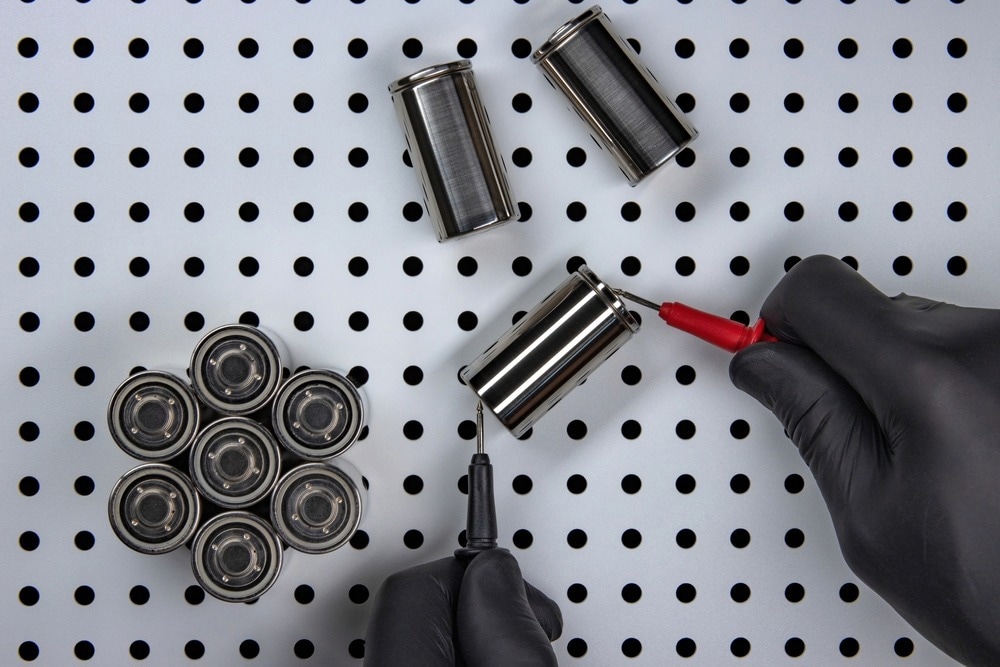In a paper recently published in the journal ACS Applies Energy Materials, researchers developed a magnetron sputter-deposited thin-film all-solid-state Li-metal battery (ASSB) consisting of a high-voltage LiNi0.5Mn1.5O4 (LNMO) cathode, a Li3PO4-xNx (LiPON) ceramic electrolyte, and a thermally evaporated metallic lithium (Li) anode. The electrochemical and structural characteristics of all electro-active battery components were analyzed prior to setting up the cell.

Study: Monolithic All-Solid-State High-Voltage Li-Metal Thin-Film Rechargeable Battery. Image Credit: Troggt/Shutterstock.com
Background
The development of novel, long-lasting, high-energy-density powering devices that outperform existing Li-ion batteries is necessary due to the Internet of Things (IoT) revolution, comprised of millions of energy-demanding, interconnected, smart sensors and microdevices. To address the technological limitations associated with liquid electrolytes, ASSBs, in which a solid Li-ion conductor replaces the liquid electrolyte, are becoming increasingly popular.
Ceramics and polymers are two primary materials that produce electrochemically and mechanically stable and conductive Li-ion solid electrolytes. The poor interconnection of the electrode-electrolyte solid-solid interface is often cited as the main hindrance to the full utilization of the electro-active materials' electrochemical properties. This limitation persists despite the substantial efforts focused on developing solid-state batteries as well as the recognized gaps concerning design engineering, processing science, and materials science.
About the Study
In this study, LNMO was deposited on inexpensive stainless-steel discs utilizing magnetron sputtering based on a dual technology system and a circular 12 mm mask. This was followed by annealing the LNMO film for one hour up to 600 °C after deposition. Thin LiPON electrolytes were deposited using radio frequency (RF) reactive magnetron sputtering featuring full-face erosion, which used motor-driven dynamic plasma scanning to sputter the entire target surface. Furthermore, Si (100) single-crystal substrates that were atomically flat were used for growing the LiPON thin films and their elemental, morphological, and structural characterization.
Thermal evaporation employing commercial crucibles consisting of evaporated materials was used to deposit the Li metal anode. The monolithic ASSB was assembled in a sequential procedure in which the constituents were grown layer over layer. To conduct galvanostatic cycling, the finished cells were attached to a battery cycler, which was placed under a controlled temperature (25 °C).
Observations
The prepared LiPON thin films were confirmed to be amorphous by X-ray diffraction tests. The P 2p photoelectron line for the three LiPON films produced a quasi-symmetrical peak, with no shape variation after nitridation. It was found that the addition of nitrogen decreased the oxygen content and vice versa for nitrogen content. The Li 1s spectra similarly exhibited a quasi-symmetrical form.
The results implied that for the optimal volume of nitrogen to be incorporated into the LiPON system, an N2-saturated background pressure was recommended during sputtering deposition. It was determined that the deposited anode surface was mostly made up of carbonates and oxides. The Arrhenius depiction of the ionic conductivity demonstrated that the addition of nitrogen substantially increased the LiPON ionic conductivity.
The cathode/electrolyte/anode cell stack had less than 5 μm thickness, as determined from the cross-sectional scanning electron microscopy (SEM) of the thin-film cell. It was also possible to infer that the several uniform defect-free thin films adhered effectively to one another without any signs of an intermediary freshly produced layer. The liquid electrolyte drop, as observed, improved ion diffusion between the LiPON and the Li foil. In comparison to the interfacial reactions corresponding to the Li foil, the reactions between the solid electrolyte and the evaporated Li anode appeared to be more active. A set of voltage tests showed that the fabricated high-voltage pouch cell delivered 4.72 V of nominal voltage. Additionally, the cell was capable of powering two series-connected red LEDs with a forward voltage of 2.1 V.
Conclusions
To summarize, the researchers used an inexpensive stainless-steel sheet for the layer-by-layer deposition of an LNMO cathode, a LiPON solid electrolyte as well as an evaporated Li anode in a practical, high-voltage ASSB. AC magnetron sputtering was a low-power processing method with a lesser technical complexity, leading to an inexpensive processing method, in addition to enhancing the deposition rates and process stability.
Moreover, the Li foil and LiPON were not in contact, which reduced the amount of ion diffusion between the electrolyte and the anode, thus weakening the electrochemical efficiency of the cell. However, in contrast to the values under 60 mAh g-1 while using a Li foil with a liquid electrolyte and those below 40 mAh g-1 while using a Li foil, the evaporated Li cells attained a greater specific capacity after 25 cycles of over 70 mAh g-1. According to the authors, these results could be a substantial step forward towards the realization of a high-voltage, practical thin-film battery based on abundant and inexpensive stainless-steel substrates.
More from AZoM: How Far Can Semiconductor Manufacturing Be Automated?
Further Reading
Madinabeitia, I., et al., Monolithic All-Solid-State High-Voltage Li-Metal Thin-Film Rechargeable Battery, ACS Applied Energy Materials, 2022, DOI: https://pubs.acs.org/doi/full/10.1021/acsaem.2c01581
Disclaimer: The views expressed here are those of the author expressed in their private capacity and do not necessarily represent the views of AZoM.com Limited T/A AZoNetwork the owner and operator of this website. This disclaimer forms part of the Terms and conditions of use of this website.